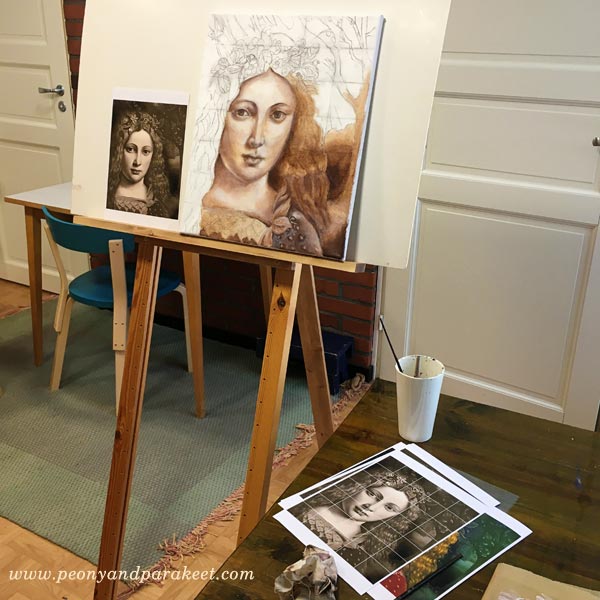
This blog post is about composing new art by using reference images. At the moment, I have a couple of paintings in progress that are based on reference images, and I also show other examples as well.
Why Don’t Artists Always Tell About Using Reference Images?
While painting my first oil painting at The National Museum of Finland, the visitors of the museum were able to visit the studio and watch us paint. Many people asked why we paint copies of the old paintings. The teacher Emmi Mustonen replied that it’s a good way to learn the old painting techniques and develop the understanding of formal elements. But I got the feeling that some of the people didn’t get it. Their facial expressions were imprinted on my mind, and it made me ponder why using reference images raises conflicting feelings.
Even if most artists who create realistic art or include realistic elements in their art, use reference images, many are not very open about it. I think that one reason is that many artists believe that people know that already and another reason that the process is not interesting. My experience is that there are surprisingly many people who assume that artists don’t take photos or use other than live models. And to me, the process of composing a new image from old ones is fascinating. I always stop to see an article where an artist shows how the reference images were used. I am especially interested if it’s about choosing the photos and combining several reference images into one piece.
Strawberry Madonna – Combining Several Reference Images to Tell a Story
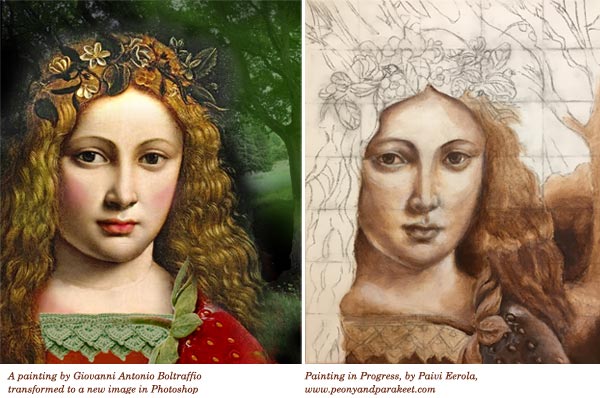
I am currently painting an acrylic painting on canvas that I call “Strawberry Madonna.” It’s my first using old masters’ painting techniques with acrylics instead of oil paints. The idea for the painting started differently than usually. I invented the title first and then started to think how Strawberry Madonna would look. I wanted to find a young woman who would have lips like she had just eaten a strawberry. By googling Renaissance paintings, I found Giovanni Antonio Boltraffio‘s painting. After that, I moved to building a story around the original idea.
Strawberry Madonnas are young girls who enjoy life without worries, have long summer holidays, eat strawberries, learn to crochet and read books like Emily of the New Moon or Anne of Green Gables. I have been one of them, and I feel quite nostalgic about it. I wanted the painting to include surrealistic elements. It has a big strawberry that is placed so that it could be a sleeve of the madonna’s dress. I am also going to change the flowers in the hair wreath to strawberry flowers and play with green and red paint. It will happen when I move on from underpainting to adding colors. In the background, there’s a photo that I took last summer. I am going to make it a little less detailed.
I used Photoshop to compose the reference image and made the sketch on canvas with charcoal. I drew a grid to make the sketching quicker.
Girl with a Ferret – Changing the Meaning with a Simple Trick
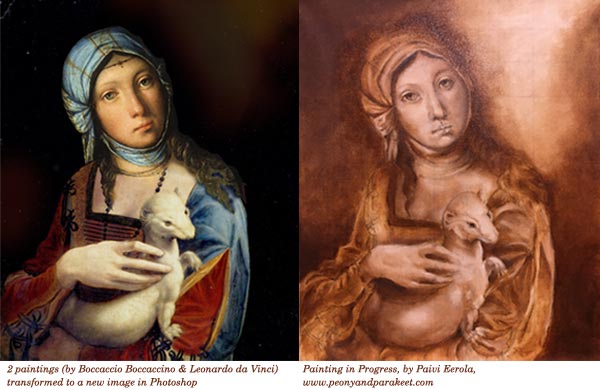
I have also started a new oil painting under the guidance of Emmi Mustonen. I got to pick the reference image freely. I wanted to pick an old Renessaince painting, but I couldn’t find any that would have a couple of my favorite features when painting with old masters’ techniques. I love to paint fur and fabric, and I wanted to find a face that would include openness. I fell in love with Boccaccio Boccaccino‘s portrait of a gypsy girl, but it didn’t have any fur. So I remembered Leonardo da Vinci’s “Lady with an Ermine” and created a new image by combining the two in Photoshop. I have several stories about this one.
The first one is about today’s society and how the pets have become more human in our eyes. I want to show the similarities in the wild gypsy girl and the tame ferret. Another story is about young girls and their love for taking care of animals. They might not know the wildlife, but they help to rescue animals and are ready to work hard when taking care of them. They are against fur clothing and not afraid to show it. The third story goes back to the 16th century. I imagine that the gypsy girl was hired to dress up and hold the ermine because the lady didn’t have the patience to pose for the artist. In the end, she never showed. The artist became frustrated and painted the girl instead. I can imagine the magical moment when the girl realized that she would be in the final painting instead of a lady.
I would like to talk with Boccaccio Boccaccino about my version. I also wonder, how he was able to paint the portrait of the gypsy girl when the artists mostly painted for churches and aristocrats back then.
At Monet’s Garden – Including All the Good Stuff to the Same Image
Last spring, I published a mini-course called Strokes of Energy as a part of the Imagine Monthly Spring series. I asked my students to name their favorite artists, and Claude Monet was among most popular ones. But when I thought about Claude Monet, I didn’t want just to serve those who love the garden or those who adore his way to paint the sky or those who want to express the windy scenes. I wanted to have all the good stuff in one image and then some more.
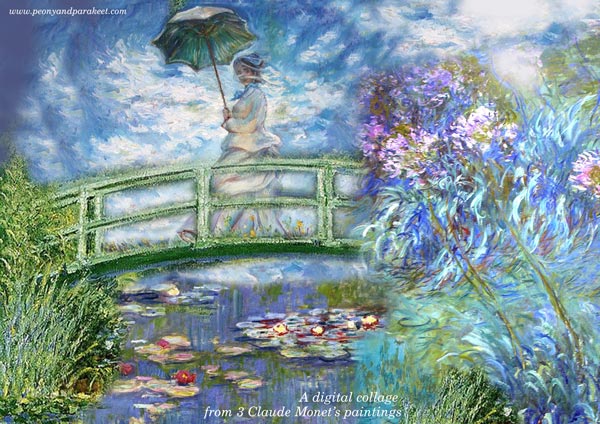
So I created a reference image in Photoshop combining three of Claude Monet’s paintings: “Woman with a Parasol” and a couple of paintings from the water lily series. Then I invented a technique where you can paint some of the elements as collage pieces so that you can adjust the overall composition before making the final decisions. This way it is possible to add more details one by one and improve the image during the actual creative process.
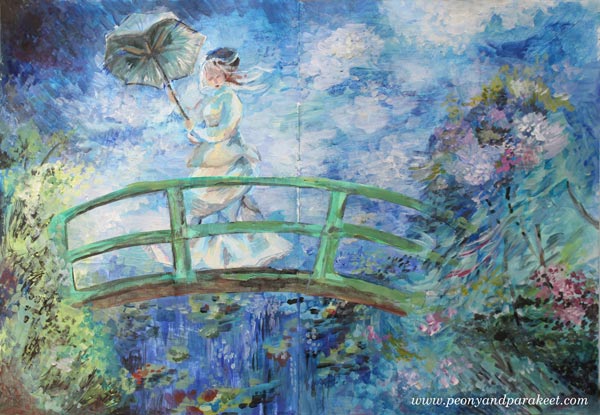
So this painting is about a woman who is experiencing strong wind. She doesn’t mind wind catching her parasol. She enjoys the fresh air and the beautiful scene around her.
Ulla’s Take
One of the students, Ulla M. Holm, made a Photoshop sketch from another set of Monet’s paintings and then painted the image with short impressionistic strokes. I love how the result also reminds me of her home country, Sweden!
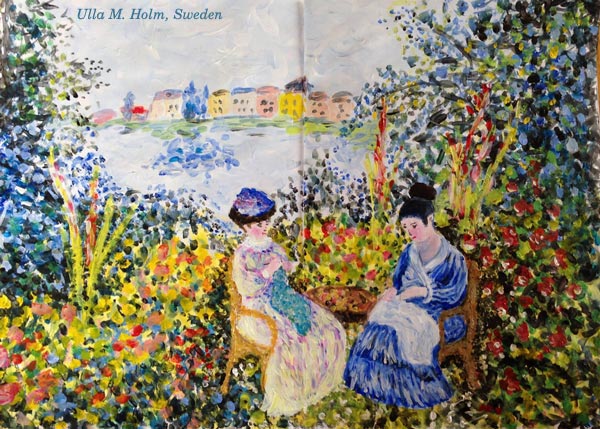
Using Reference Images More Intuitively – From a Story to an Experience
I admit having mixed feelings about following the reference images carefully. With my art, I want to express freedom, and I don’t think that following reference images too closely helps with that. On the other hand, I don’t want to restrict myself doing abstracts only or creating similar paintings one after another. Many artists create the same again and again and become better and better with that. To me, art is about exploring and the hook there is to widen my perspective continuously.
So even if you would prefer abstract art, it doesn’t mean you can’t have reference images. Instead of connecting with the actual story, you can connect with an emotional experience.

I picked colors and ideas from Emile Vernon’s painting and imagined what it would be like wearing that soft dress. The dress felt like a dream, so I wrote: “Muisto unelmasta” – “a memory of a dream” in the image.
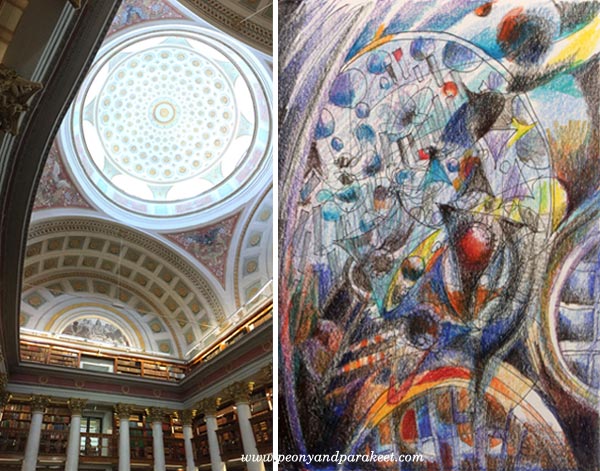
Here’s another example from my class Inspirational Drawing 2.0: a photo from The National Library of Finland and my interpretation, “The Power of Knowledge.”
Do yo want to experiment with this approach using your personal reference images? >> Sign up for Inspirational Drawing 2.0!
For the Fans of Monet – Strokes of Energy
My Monet-inspired mini-course Strokes of Energy is now available as an individual self-study course. >> Buy Strokes of Energy!
Geraldine’s Take
I want to end this blog post with a skilled artist Geraldine Norris from Australia who created her version of Monet in my class. She had just seen an art exhibition showing Monet’s work, and I think it shows how deeply she connected with the experience.
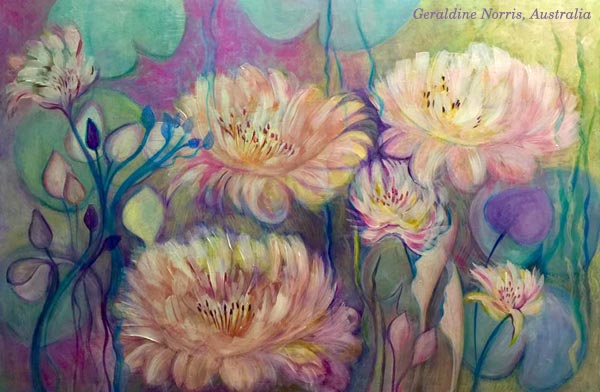
But wait, there is more beautiful Monet-inspired art from my students, see the presentation page of Strokes of Energy!
Until next time!

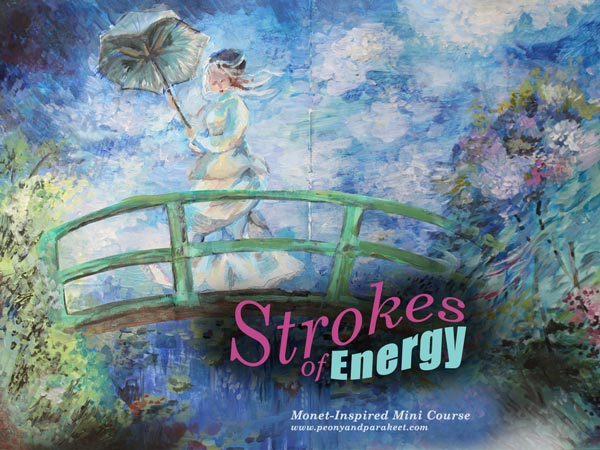
Thank you Päivi, for referring to my assignment! I’m blushing.
You’re welcome!!
It’s Beautiful ??!
Thanks, Louise!
Love this post, so interesting.
Thanks, Denise!!
Every time I look at your Monet bridge painting, I see the main element as the bridge. It ties the wildness of the sky with the refined clothing she wears. It connects the feathery greenery to the fluffy clouds and provides a path between the two worlds of calm water, thick lily pads and filmy flowers and silken fabric. I think the green color also ties the world of green growing things to the moisture in the blue sky and still waters. It bridges between the high, ethereal clouds and deep, watery, depths which also represents the ladies journey crossing a mental bridge with such determination. Your painting will always be “The Bridge” to me.
Oh, thank you so much, Mary!!
I think that what happened in the recent history of painting, especially in the 20th century, is that “originality” and “individualism” superseded technique; which became a “dirty word”. So called originality actually eroded the mastery of technique, culminating in such “unique” artistic offerings as a jar containing urine, placed as a serious exhibit in a museum for people to “ooh and ahh” over. I applaud your study of the painting techniques used by the old masters. I think this topic needs to be discussed more openly.
Thank you, Nilli! I agree with you. Even if I enjoy many kinds of art, to me, aesthetics is very important in art.
Would it be possible to explain how you put two reference images together in one piece using Photoshop? Or could you direct me to a tutorial, please? Thank you!
Here’s my quick guide:
1) Create a new blank image in Photoshop.
2) Paste the images that you want to manipulate to the blank background. Each of the images is now as a separate layer.
3) Delete the parts of the top layers so that you will get the image that you want. You can use eraser tool with a brush tip. There are more elegant ways to do that, but if you are a beginner, you can start from here.
By googling Photoshop tutorials for beginners, you will get a lot of results!
Have fun!
you created a reference image in Photoshop combining three of Claude Monet’s paintings. Can you please elaborate on this detail. I would appreciate learning how and why you did that. thank you.
Hi Dorothy, I combined three paintings to create a plan for a new painting. I wanted to get as much iconic Claude Monet pieces to one image as possible, enjoy painting something that hasn’t been painted before, and still enjoy familiar features from Claude Monet.
How: see the short version in the previous comment!
I think that most people believe ( and rightly so) that many artists copy other art work and say that it is their own ‘original ‘ art work. I’ve encountered this with many new student’s who are missing the concept……..you make copies to learn the technique…….then apply the technique to your own work ! There is nothing wrong with using reference material ( I encourage artists to use their own photos and sketches to make the work truly their own, Only using existing art work to generate new ideas. Or as a technical reference .) Thank you for addressing this subject. It is a very important distinction for all artists to remember !
Thank you for your input, Saundra! Enjoyed reading it!
Great post!! Thank you Paivi!! I always learn so much by your teachings and the questions and answers at the end!
Thanks again!
xo
~G.
Thank you, Gailie! Great to hear that you enjoyed the post! And I also love reading comments and answering questions!